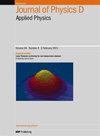Physical and chemical characteristics of plasma-activated water generated by hybrid dielectric barrier discharge and gliding arc discharge
IF 3.2
3区 物理与天体物理
Q2 PHYSICS, APPLIED
引用次数: 0
Abstract
This research explores the synergistic application of Dielectric Barrier Discharge (DBD) and Gliding Arc Plasma Jet (GAPJ) in a Hybrid Plasma Discharge (HPD) setup for enhanced water activation. The HPD system demonstrated balanced and sustained generation of reactive oxygen and nitrogen species (RONS), maintaining efficiency at higher specific input energy (SIE) values. Comparative analyses with DBD and GAPJ systems highlighted the superior performance of the HPD system in generating RONS and modifying water’s molecular structure. Key observations included a decrease in water’s pH and an increase in oxidation-reduction potential, total dissolved solids, and conductivity, stabilizing beyond 5 l min−1 airflow and 10 min of treatment. UV−Vis spectroscopy identified nitrites, nitrates, hydrogen peroxide, and nitrous acid, while Raman spectroscopy captured shifts in vibrational modes, particularly in librational and O–H stretching bands. These changes correlated with alterations in reactive species concentrations and pH levels. Overall, the HPD system emerged as a versatile and efficient approach for generating plasma-activated water, suitable for applications in microbial deactivation, surface sterilization, and electrocatalytic process optimization, offering stable and continuous production of reactive species across a range of SIE values.混合介质阻挡放电和滑弧放电产生的等离子活化水的物理和化学特性
这项研究探索了在混合等离子体放电(HPD)装置中介质阻挡放电(DBD)和滑弧等离子体射流(GAPJ)的协同应用,以增强水的活化。HPD 系统能均衡、持续地生成活性氧和氮物种 (RONS),并在较高的比输入能量 (SIE) 值下保持效率。与 DBD 和 GAPJ 系统的比较分析突出显示了 HPD 系统在生成 RONS 和改变水分子结构方面的卓越性能。主要观察结果包括水的 pH 值下降,氧化还原电位、溶解固体总量和电导率上升,并在 5 升/分钟的气流和 10 分钟的处理后趋于稳定。紫外-可见光谱法确定了亚硝酸盐、硝酸盐、过氧化氢和亚硝酸,而拉曼光谱法则捕捉到了振动模式的变化,特别是自由振动和 O-H 伸展带的变化。这些变化与活性物种浓度和 pH 值的变化相关。总之,HPD 系统是生成等离子活化水的一种多功能、高效的方法,适用于微生物失活、表面杀菌和电催化过程优化等应用,可在一定的 SIE 值范围内稳定、持续地产生反应物。
本文章由计算机程序翻译,如有差异,请以英文原文为准。
求助全文
约1分钟内获得全文
求助全文
来源期刊
CiteScore
6.80
自引率
8.80%
发文量
835
审稿时长
2.1 months
期刊介绍:
This journal is concerned with all aspects of applied physics research, from biophysics, magnetism, plasmas and semiconductors to the structure and properties of matter.

 求助内容:
求助内容: 应助结果提醒方式:
应助结果提醒方式:


